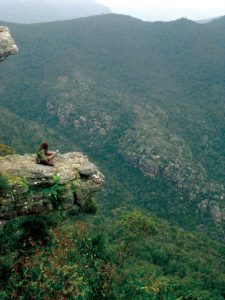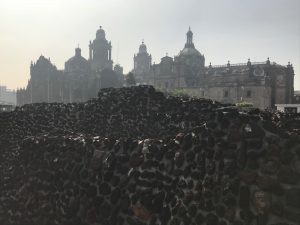
Recently, I went on a camping trip to Gariwerd, which is the traditional name of a National Park in south-west Victoria. It’s home to ninety percent of the state’s known ancient rock art, and clearly matches Graham Black’s (2012) criteria to summarise the museum and its purpose. Looking at the fading paintings conjured fear. How, without the ability to stop time, can we preserve their authenticity and mystique? Is uploading a photo to “Instaspam” enough? My investigations turned into the first episode of a podcast: Tentacles of Thought.
I’ve summarised the message of the episode as “optimistic indifference”, because, history has thrown far greater threats at First Nations heritage than the world of digital media ever could. Using Mukurtu CMS as an example demonstrates strong optimism in embracing new technologies, yet I cannot ignore that ongoing digital divides make this bittersweet for First Nations peoples.

I scripted, rewrote and modified the rewritten material in a studio. Taking advantage of a quiet night and acoustic damping, I used a Focusrite, Audacity, a Shure SM58 and an extremely critical ear for my own voice. Finally, I mastered the podcast using DJ software, Traktor Pro, to treat the vocals and music like songs in a setlist. I could easily add effects like reverb and delay, EQ the seperate elements, and get their relative volume levels just right in real-time.
After extensive reading, I found it difficult to consolidate my thoughts in a six-minute podcast. With so many inspirational examples of digital First Nations heritage, I would have enjoyed more time to explore them, or further unpack the issues I’ve encountered. The research I chose to include was selected to support and contextualise my claims of optimism and indifference, alongside the closely related issue of digital divides.
The music included in the podcast is a release that highlights the complicated nature of copyright. The artist, Nickynutz, doesn’t usually release free tunes. This track is what DJs call a “bootleg” – a usually anonymous solution to the grey areas of plagiarism. Here, the original song is an unreleased version of Youthman in the Ghetto by Prince Allah, and Nickynutz has remixed it (fittingly) for free.
Prince Allah – Youthman in the Ghetto by Nickynutz (CC BY 3.0)
The Yidaki (digeridoo) was recorded using the equipment listed above and the addition of a Shure SM57. This was done in a solid stone/concrete room to take advantage of natural reverberation. I have played these amazing instruments from an early age.
The first challenge I faced was in my research. I found it difficult to look beyond the fact that “post” colonial ideas of cultural heritage dominated the literature I found. However, the biggest challenge was adapting the tone of my academic writing to the conversational arena of podcasting. My first script, basically, projected aggressive desires to study de-colonisation, and my second was more of a focused essay.
Enlightenment came realising that nobody wants to hear me say this next particular sentence, which is better when left to be read, right?
Mukurtu digitises cultural heritage foremost using First Nations perspectives and knowledge when structuring the metadata of online materials. How do you structure your metadata?#mukurtu #culturalheritage #FirstNations #ALC708https://t.co/CXFzslSDpf
— Kal Omari (@kal_omari) May 3, 2019
Photos by Kal Omari
Share this:
References (including podcast):
Black, G 2012, Transforming museums in the twenty-first century, Routledge, London, retrieved 9 April 2019, https://ebookcentral-proquest-com.ezproxy-f.deakin.edu.au/…
Brown, D 2007, ‘Te Ahua Hiko: Digital Cultural Heritage and Indigenous Objects, People, and Environments’, in Cameron, F, Kenderdine, S (eds), Theorizing digital cultural heritage: a critical discourse, MIT Press, Cambridge, pp.77-91
Byrne, A 2008, ‘Digitising and handling Indigenous cultural resources in libraries, archives and museums’, paper in session Making the intangible tangible, at Communities and memories: a global perspective: Memory of the World Conference, National Library of Australia, Canberra, retrieved 9 April 2019, http://www.unesco.org/ […] .pdf
Francis, KD, Liew, CL 2009, ‘Digitised Indigenous knowledge in cultural heritage organisations in Australia and New Zealand: An examination of policy and protocols’, Proceedings of the ASIST annual meeting, vol.46, no.1, pp.1-21, retrieved 9 April 2019, DOI: 10.1002/meet.2009.145046025
Hoffman, BT 2006, Art and cultural heritage : law, policy, and practice, Cambridge University Press, New York
Mukurtu CMS, Center for Digital Scholarship and Curation, Washington State University, website, retrieved 9 April 2019, http://mukurtu.org
Nakata, M, Byrne, A, & Nakata, V 2005, ‘Libraries, Indigenous Australians and a Developing Protocols Strategy for the Library and Information Sector’, Australian Academic & Research Libraries, vol.36, no.2, pp.195-210
Nakata, M, Nakata, V, Gardiner, G, McKeough, J, Byrne, A, Gibson, J 2008, ‘Indigenous digital collections: An early look at the organisation and culture interface’, Australian Academic and Research Libraries, vol.39, no.4, pp.223-236
Russell, L 2005, ‘Indigenous Knowledge and Archives: Accessing Hidden History and Understandings’, Australian Academic & Research Libraries, vol.36, no.2, pp.169-180
Senier, S 2014, ‘Digitizing Indigenous History: Trends and challenges’, Journal of Victorian Culture, vol.19, no.3, pp.396-402, retrieved 9 April 2019, DOI:10.1080/13555502.2014.947188
Sullivan, R 2002, Indigenous cultural and intellectual property rights. A digital library context, DLib Magazine, vol.8, no.5, retrieved 13 April 2019, http://www.dlib.org/ […] .pdf